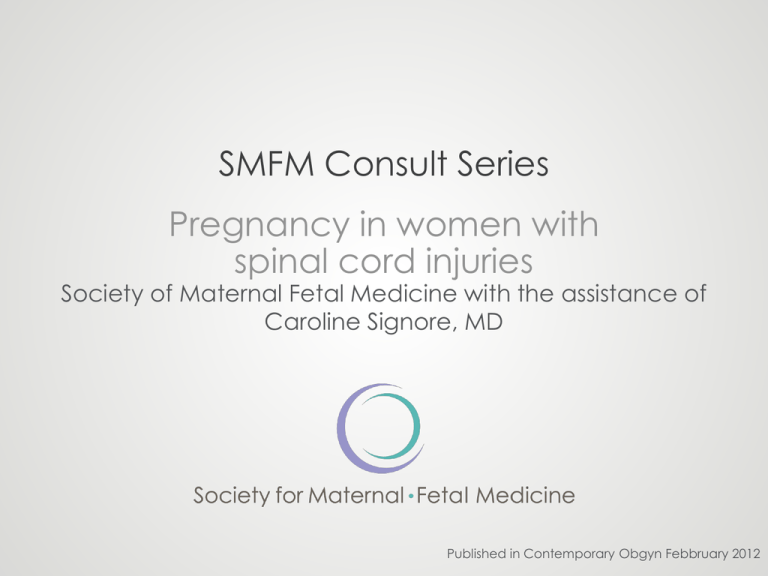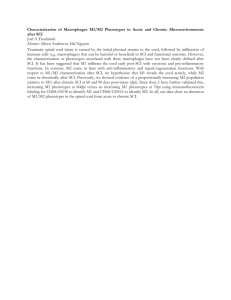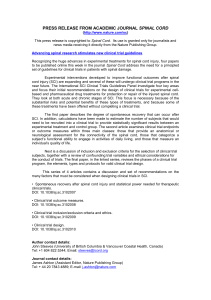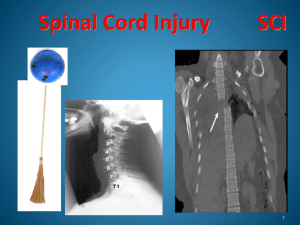Perineal care - s3.amazonaws.com
advertisement

S M M SMFM Consult Series Pregnancy in women with spinal cord injuries Society of Maternal Fetal Medicine with the assistance of Caroline Signore, MD Published in Contemporary Obgyn Febbruary 2012 Antenatal Care: SCI Most gravidas with SCI will experience few serious complications of pregnancy and will deliver healthy infants. No Reason to discourage or terminate a pregnancy simply on the basis of a maternal SCI. Antenatal care should be provided by a multidisciplinary teaam: Obstetrician and/or maternal-fetal medicine specialist Neurologist Physiatrist, Urologist Obstetric anesthesiologist Nurses Physical and occupational therapists S M M Antenatal Care SCI Management: Urinary dysfunction Chronic urinary dysfunction related to neurogenic bladder Many women with lower lesions are capable of, and should perform, intermittent self-catheterization. Indwelling urethral or suprapubic catheters are the norm among women with tetraplegia (eg, quadriplegia: loss of sensory and muscular use of both upper and lower extremities). Women with SCI may experience pregnancy-related changes in bladder function and management: Increases in bladder spasms Need for more frequent catheterization Leakage around indwelling catheters Self-catheterization is the preferred approach throughout pregnancy because of the increased risks of urinary tract infection (UTI) with chronic indwelling catheters. Up to 25% of women with SCI may require a change in bladder management because of chronic urine leakage and/or bladder spasms (eg, expelling indwelling catheter); thus, referral for urology or urogynecology consultation may be useful in these situations S M M Antenatal Care SCI Management: UTI Asymptomatic bacteriuria occurs in the majority of pregnant women with SCI. In a general obstetric population, the frequency of asymptomatic bacteriuria is 2% to 7%, and without treatment, 30% to 40% of these women will progress to UTI. American College of Obstetricians and Gynecologists (ACOG) Committee Opinion on SCI in pregnancy suggests that frequent urine cultures or antibiotic suppression are indicated Urine cultures for the detection of asymptomatic bacteriuria can be done monthly or once per trimester, depending on the frequency of positive cultures and prior infections Chronic antibiotic suppression may be considered for women with recurrent UTIs and/or indwelling catheters. Antibiotic regimens should be directed on the basis of culture results; commonly used agents include nitrofurantoin and trimethoprim-sulfamethoxazole S M M Antenatal Care SCI Management: Decubitus Ulcer Decubitus ulcers occur in 5% to 10% of women with SCI Contributing factors that increase risk of skin breakdown in pregnancy include: Gestational weight gain Inadequately sized or cushioned wheelchairs or other medical equipment Dependent edema Anemia Poor nutrition Smoking Patients should be advised to change positions and perform pressure-relief maneuvers regularly and to inspect equipment for appropriate fit and padding Frequent skin inspections at home and during office visits are recommended. If there is evidence or concern for skin breakdown or potential injury, communication with the patient's physical medicine and/or rehabilitation team is warranted S M M Antenatal Care SCI Management: Respiratory System Baseline respiratory function may be impaired in SCI because of weakened respiratory musculature or chest deformity from posttraumatic kyphoscoliosis, especially those women with higher thoracic or cervical lesions (eg, above T5). Respiratory impairment may be exacerbated by pregnancy, with the gravid uterus further limiting diaphragmatic excursion. Supine positioning may worsen symptoms. In selected women with SCI, baseline and serial pulmonary function tests may be performed to assess vital capacity and the possible need for ventilator support during labor (eg, if vital capacity is <13 mL/kg) Referral to a pulmonologist may be appropriate for women with chronic respiratory symptoms and those with lower vital capacity S M M Antenatal Care SCI Management: Preterm labor Women with SCI above T10 may not perceive the pain of uterine contractions and are therefore at risk of unattended preterm or term birth. Increased risk of preterm birth (21% to 27%) among women with SCI Women and/or their caregivers should be instructed how to palpate for uterine contractions They also should be advised they may experience unique indicators of labor, such as increases in spasticity, symptoms of autonomic dysreflexia (AD), referred pain above-the-cord lesion, or shortness of breath. S M M Antenatal Care SCI Management: Venous Tromboembolism The combination of impaired mobility and the hypercoagulable state of pregnancy raises concern for thromboembolic disease in women with SCI There is insufficient data to recommend universal pharmacological thromboprophylaxis (eg, low molecular weight heparin) during pregnancy of all women with SCI Pharmacologic treatment should be individualized based on patient medical history and physical limitations S M M Antenatal Care SCI Management: Fetal Risks Among women with SCI prior to conception, there does not appear to be an increased risk of fetal malformations, miscarriage, or stillbirth Common concern in SCI pregnancy is fetal exposure to maternal medications. Ideally, women with SCI should receive preconception counseling so that risks and benefits of continuing medication use can be discussed. In general, most medications given to women with SCI can be safely continued during pregnancy, but the maternal-fetal medicine specialist should be contacted when new medications are considered or with changes in dosing regimens S M M Intrapartum Management: Autonomic Dysreflexia AD, is a potentially life-threatening syndrome AD: marked hypertension and cardiac dysrhythmias AD is common during pregnancy in women with spinal cord lesions at T6 or higher (85%), but has been reported with lower-level injuries (20% of women with thoracic lesions) The condition is precipitated by a strong or noxious stimulus below the level of the spinal lesion (eg, distension of bladder or bowel, or vaginal examination) that initiates an uncontrolled reflex sympathetic response. Uterine contractions also can be a potent inciting factor. The hypertension associated with AD can be extreme and must be differentiated from that of preeclampsia so that appropriate therapy can be initiated. A key difference is that in AD, blood pressure tends to normalize between contractions, whereas blood pressure elevations in preeclampsia are more persistent. Other signs and symptoms of AD include maternal bradycardia or tachycardia, headache, flushing, piloerection, nasal congestion, diaphoresis, and anxiety. The severity of AD can range from mildly aggravating symptoms to a hypertensive crisis leading to encephalopathy, cerebral or retinal hemorrhage, coma, and death. Maternal vasoconstriction can lead to acute uteroplacental insufficiency. Prevention should be the first goal of management of AD Induction of regional anesthesia early in labor is the preferred preventive strategy, and has been shown to be effective in decreasing the severity of AD. Because of the risk of AD, several experts recommend that women with SCI should deliver in a unit capable of invasive hemodynamic monitoring.1,13 Cesarean delivery may be required if AD symptoms, especially malignant hypertension, cannot be controlled with pharmacotherapy. S M M Intrapartum Management: Labor & Delivery If cervical ripening is required, regional anesthesia should be considered at the outset. Proper cushioning in bed, regular changes in position, and frequent skin inspections during labor are imperative to avoid skin breakdown and/or decubitus ulceration. Women with SCI are capable of vaginal delivery, though some may require operative vaginal delivery to compensate for weaker voluntary expulsive ability in the second stage and/or to manage autonomic dysreflexia. A number of reports suggest an increased rate of cesarean delivery among parturients with SCI, but it is not clear whether these are performed for standard obstetric indications, especially malignant hypertension, cannot be controlled with pharmacotherapy. S M M Postpartum Care: Patients with SCI Postpartum autonomic dysreflexia Careful blood pressure monitoring should continue after delivery. Care should be taken to avoid bladder distension, another common precipitant of AD. During the immediate recovery phase (12 hours for vaginal and 24 hours for cesarean delivery), short-term placement of an indwelling Foley catheter may decrease this risk. Bowel regimen should be restarted to avoid complications related to constipation. Perineal care Because of diminished perineal sensation in women with SCI, ice packs or heating pads for perineal care in the postpartum unit should be used with caution. A bowel program that relies on digital stimulation will need to be modified in the setting of a third- or fourth-degree laceration repair to permit adequate healing. Lactation Breastfeeding should be encouraged for women with SCI. S M M Management: Summary S M M S M M References 1. Pereira L. Obstetric management of the patient with spinal cord injury. Obstet Gynecol Surv. 2003;58(10):678-687. 2. Signore C, Spong CY, Krotoski D, Shinowara NL, Blackwell SC. Pregnancy in women with physical disabilities. Obstet Gynecol. 2011;117(4):935-947. 3. American College of Obstetricians and Gynecologists. ACOG Committee Opinion: No. 275, September 2002. Obstetric management of patients with spinal cord injuries. Obstet Gynecol. 2002;100(3):625-627. 4. Jackson AB, Wadley V. A multicenter study of women's self-reported reproductive health after spinal cord injury. Arch Phys Med Rehabil. 1999;80(11):1420-1428. 5. Pannek J, Bertschy S. Mission impossible? Urological management of patients with spinal cord injury during pregnancy: a systematic review. Spinal Cord. 2011;49(10):1028-1032. 6. Gilstrap LC 3rd, Ramin SM. Urinary tract infections during pregnancy. Obstet Gynecol Clin North Am. 2001;28(3):581-591. 7. Jackson AB, Lindsey LL, Klebine PL, Poczatek RB. Reproductive health for women with spinal cord injury: pregnancy and delivery. SCI Nurs. 2004;21(2):88-91. 8. James A; American College of Obstetricians and Gynecologists, Committee on Practice Bulletins—Obstetrics. ACOG Practice bulletin no. 123: thromboembolism in pregnancy. (Replaces Practice Bulletin No. 19, August 2000). Obstet Gynecol. 2011;118(3):718-729. 9. Teasell RW, Hsieh JT, Aubut JA, Eng JJ, Krassioukov A, Tu L; Spinal Cord Injury Rehabilitation Evidence Review Research Team. Venous thromboembolism after spinal cord injury. Arch Phys Med Rehabil. 2009;90(2):232-245. 10. Krassioukov A, Eng JJ, Warburton DE, Teasell R; Spinal Cord Injury Rehabilitation Evidence Research Team. A systematic review of the management of orthostatic hypotension after spinal cord injury. Arch Phys Med Rehabil. 2009;90(5):876-885. 11. Gimovsky ML, Ojeda A, Ozaki R, Zerne S. Management of autonomic hyperreflexia associated with a low thoracic spinal cord lesion. Am J Obstet Gynecol. 1985;153(2):223-224. 12. Krassioukov A, Warburton DE, Teasell R, Eng JJ; Spinal Cord Injury Rehabilitation Evidence Research Team. A systematic review of the management of autonomic dysreflexia after spinal cord injury. Arch Phys Med Rehabil. 2009;90(4):682-695. 13. Baker ER, Cardenas DD, Benedetti TJ. Risks associated with pregnancy in spinal cord-injured women. Obstet Gynecol. 1992;80(3 Pt 1):425-428. 14. Hughes RB, Nosek MA, Robinson-Whelen S. Correlates of depression in rural women with physical disabilities. J Obstet Gynecol Neonatal Nurs. 2007;36(1):105-114. 15. Alexander CJ, Hwang K, Sipski ML. Mothers with spinal cord injuries: impact on marital, family, and children's adjustment. Arch Phys Med Rehabil. 2002;83(1):24-30. 16. Ghidini A, Healey A, Andreani M, Simonson MR. Pregnancy and women with spinal cord injuries. Acta Obstet Gynecol Scand. 2008;87(10):10061010. 17. Burns AS, Jackson AB. Gynecologic and reproductive issues in women with spinal cord injury. Phys Med Rehabil Clin N Am. 2001;12(1):183-199. 18. Westgren N, Hultling C, Levi R, Westgren M. Pregnancy and delivery in women with a traumatic spinal cord injury in Sweden, 1980-1991. Obstet Gynecol. 1993;81(6):926-930. 19. Westgren N, Levi R. Motherhood after traumatic spinal cord injury. Paraplegia. 1994;32(8):517-523. Society for Maternal-Fetal Medicine Disclaimer The practice of medicine continues to evolve, and individual circumstances will vary. This opinion reflects information available at the time of its submission for publication and is neither designed nor intended to establish an exclusive standard of perinatal care. This presentation is not expected to reflect the opinions of all members of the Society for Maternal-Fetal Medicine. These slides are for personal, noncommercial and educational use only S M M Disclosures This opinion was developed by the Publications Committee of the Society for Maternal Fetal Medicine with the assistance of Stanley M. Berry, MD, Joanne Stone, MD, Mary Norton, MD, Donna Johnson, MD, and Vincenzo Berghella, MD, and was approved by the executive committee of the society on March 11, 2012. Dr Berghella and each member of the publications committee (Vincenzo Berghella, MD [chair], Sean Blackwell, MD [vice-chair], Brenna Anderson, MD, Suneet P. Chauhan, MD, Jodi Dashe, MD, Cynthia Gyamfi-Bannerman, MD, Donna Johnson, MD, Sarah Little, MD, Kate Menard, MD, Mary Norton, MD, George Saade, MD, Neil Silverman, MD, Hyagriv Simhan, MD, Joanne Stone, MD, Alan Tita, MD, Michael Varner, MD) have submitted a conflict of interest disclosure delineating personal, professional, and/or business interests that might be perceived as a real or potential conflict of interest in relation to this publication. S M M






